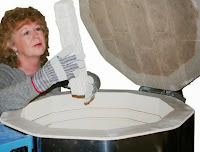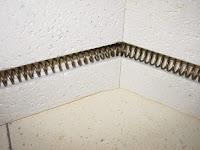Circuit Breakers
Jen-Ken Kilns
Kiln Care
Kiln Equipment
Kiln Lifespan
Kiln Maintenance
Kiln Safety
Kiln Tips
Kiln Troubleshooting
kiln-education
Kilns
Paragon Kilns
Top things to do to your kiln
What I'm Supposed to Do Before Firing My Kiln..... and other things I'm probably forgetting to do!
Most of us are so excited about what we're putting into our kilns, that we forget we need stop and inspect the kiln carefully prior to each firing. Caring for you kiln is an easy task that, if you pay attention to the small things, can save you down time and lots of maintenance dollars. Doing these simple steps every time can help your kiln last a really, really, really long time!
Vacuum. Turn off the power switch! Then, vacuum all brick areas on the inside of your kiln! Make sure there is no loose fiber paper, blanket or other refractory material that is unneeded in the kiln. Extra burnout of unnecessary fiber smells crummy and may contribute to devitrification. This includes the inside of the lid, around your elements on the side, and the bottom. Your vacuum should have a HEPA filter, to protect you from inhaling dust. Ideally you would use a shop VAC with a separately purchased HEPA filter. Make sure you are using a soft brush attachment. You are vacuuming because you must remove all kiln brick dust, sand, and residue that could settle into your glass during the firing.
Clean. Make sure the area is really clean - remove all flammable or combustible materials such as curtains, plastics, rags, paper, packing materials, etc. from the area surrounding the kiln.
Inspect. Make sure all the coils/elements are in their designated place and tuck everything in where it belongs. Make sure the elements and their respective channels have no glass, glazes, or metal fragments, crustings, etc. Push all loose element pins back into place. Inspect your thermocouple for any signs of damage and replace immediately if needed. Tighten screws in the lid band, if necessary.
Check for cracks. Check your shelf for cracks before firing. This may prevent the possible disappointment of the shelf breaking mid-firing. Sand any rough spots on the bottom or shelves and recoat with kiln wash. It is not necessary to kiln wash between each firing but a sufficient coating should be maintained.
Power Up! Turn the power switch back on and make sure your kiln registers an appropriate room temperature for the inside of the kiln.
Do a Body Check Up! The only things inside of your kiln should be your elements, pins, brick, kiln furniture/posts and kiln washed shelves. Turn off the power to the kiln and remove anything else (glaze, slip, clay, glass, silica sand) from the sidewalls before firing. We are doing this for the same reasons we vacuum the lid. Leaving this material in the kiln will damage the sidewalls and possibly the heating elements. Remove the material with a small screwdriver or knife. Be careful not to gauge the brick. It's possible that small pieces of brick will break free from the sidewall. Most cracks are cosmetic in nature and will have no impact on your firings. On occasion, a small crack can become a problem that can be repaired with kiln cement. Be as neat as possible and be mindful not to get cement on the heating elements, as this could destroy the element. If a sidewall crack is creating a structural problem, then it’s time to call in the kiln repair person, or call the manufacturer. Structural problems will be handled in short order by most manufacturers during the warranty period. If you are in the warranty period, DO NOT ATTEMPT TO REPAIR THIS without calling the manufacturer, as this could void your warranty.
Visually Inspect The Elements! Rusty, bulging, and thinning or thickened areas of your elements mean wear is happening. Elements don’t last forever, so expect to change your elements at some point during the life of your kiln. Element wear is based on the number of firings you do, and the environment or climate where the kiln resides. Just like tires on a car, mileage equals wear. In a kiln, the hours firing are equivalent to miles. The more hours you fire, the wear you’ll see on your elements. The thicker the gage of the element coil wire the more resilient the element will be. Keep in mind that each manufacturer has taken great care to size the element coils for the amount of amperage that they will carry to get the job done well. If you find it necessary to change out your elements, make sure you speak to the manufacturer to determine the appropriate element size for your kiln. Please refer to your operator’s manual for the discussion and photo's of "Element Replacement".
Perform an Electrical Check Up! Perform an Electrical Check Up! Periodically inspect the power cable, receptacle, and plug for any signs of discoloration or heat. Make sure all connections in the receptacle and plug are tight. Check plug regularly for corrosion or dark spots. If corrosion or discoloration occurs, replace the plug and receptacle. Touch the plug and receptacle regularly to make sure it is not hot. If it does feel hot, check for loose connections and corrosion. Do not continue firing until the problem is fixed. Replacing the cord set or the receptacle may be necessary. If an electrical problem occurs and it becomes necessary replace any part of the plug assembly, then it’s time to call in the kiln repair person, or call the manufacturer. Electrical problems will be handled in short order by most manufacturers during the warranty period. If you are in the warranty period, DO NOT ATTEMPT TO REPAIR THIS without calling the manufacturer, as this could void your warranty.
***Don't take any of these check up steps for granted!*** The long life and resale value of your kiln depend on these steps! Now that I've reminded you....my work here is done! Go fuse, fire, slump, rake, drape, and drip to your hearts content!
Your Kiln Gal,
Gail... Special thanks to our friends at Paragon and Jen-Ken Kilns for the use of their pix!
Before EVERY firing...
Look. Take a gander inside of your kiln and make sure nothing has taken up residence. You think we’re kidding, but sometimes, especially if your kiln lives in your garage or basement, insects or even a critter could have taken up temporary quarters if you left the top open. If you have house pets and the kiln is in an area that your pets can access, make sure that none of your little friends have left you a liquid present near the kiln. Moisture and electricity don’t mix, and really smell up the joint! Avoid installing kilns in a damp area. This could cause corrosion on the plug. Even if there is no critter present, sometimes droppings around your kiln can be a telltale sign you have guests in the vicinity. Check for anything out of the ordinary.Clean. Make sure the area is really clean - remove all flammable or combustible materials such as curtains, plastics, rags, paper, packing materials, etc. from the area surrounding the kiln.
Inspect. Make sure all the coils/elements are in their designated place and tuck everything in where it belongs. Make sure the elements and their respective channels have no glass, glazes, or metal fragments, crustings, etc. Push all loose element pins back into place. Inspect your thermocouple for any signs of damage and replace immediately if needed. Tighten screws in the lid band, if necessary.
Check for cracks. Check your shelf for cracks before firing. This may prevent the possible disappointment of the shelf breaking mid-firing. Sand any rough spots on the bottom or shelves and recoat with kiln wash. It is not necessary to kiln wash between each firing but a sufficient coating should be maintained.
Power Up! Turn the power switch back on and make sure your kiln registers an appropriate room temperature for the inside of the kiln.
Regular MONTHLY maintenance check up…
Do a Lid Check Up! During every firing the kiln lid expands and contracts. All this action will make it necessary to tighten the lid band occasionally. Carefully, using the correct tool, tighten the band, being mindful not to strip threads. Most kiln lids are manufactured with a protective coating on the "hot side" or inside. This coating was applied to optimize the heat insulation of the lid, as well as to prevent brick dust from falling into the kiln. Of course this cannot be completely prevented. Because of all of this expansion and contraction over the years, cracks may appear in the lid. Most cracks are cosmetic in nature and will have no impact on your firings. Sometimes, a small crack can become a problem that can be repaired with kiln cement. If a lid crack is creating a structural problem, then it’s time to call in the kiln repair person, or call the manufacturer. Structural problems will be handled in short order by most manufacturers during the warranty period. If you are in the warranty period, DO NOT ATTEMPT TO REPAIR THIS without calling the manufacturer, as this could void your warranty.Do a Body Check Up! The only things inside of your kiln should be your elements, pins, brick, kiln furniture/posts and kiln washed shelves. Turn off the power to the kiln and remove anything else (glaze, slip, clay, glass, silica sand) from the sidewalls before firing. We are doing this for the same reasons we vacuum the lid. Leaving this material in the kiln will damage the sidewalls and possibly the heating elements. Remove the material with a small screwdriver or knife. Be careful not to gauge the brick. It's possible that small pieces of brick will break free from the sidewall. Most cracks are cosmetic in nature and will have no impact on your firings. On occasion, a small crack can become a problem that can be repaired with kiln cement. Be as neat as possible and be mindful not to get cement on the heating elements, as this could destroy the element. If a sidewall crack is creating a structural problem, then it’s time to call in the kiln repair person, or call the manufacturer. Structural problems will be handled in short order by most manufacturers during the warranty period. If you are in the warranty period, DO NOT ATTEMPT TO REPAIR THIS without calling the manufacturer, as this could void your warranty.
Visually Inspect The Elements! Rusty, bulging, and thinning or thickened areas of your elements mean wear is happening. Elements don’t last forever, so expect to change your elements at some point during the life of your kiln. Element wear is based on the number of firings you do, and the environment or climate where the kiln resides. Just like tires on a car, mileage equals wear. In a kiln, the hours firing are equivalent to miles. The more hours you fire, the wear you’ll see on your elements. The thicker the gage of the element coil wire the more resilient the element will be. Keep in mind that each manufacturer has taken great care to size the element coils for the amount of amperage that they will carry to get the job done well. If you find it necessary to change out your elements, make sure you speak to the manufacturer to determine the appropriate element size for your kiln. Please refer to your operator’s manual for the discussion and photo's of "Element Replacement".
***Don't take any of these check up steps for granted!*** The long life and resale value of your kiln depend on these steps! Now that I've reminded you....my work here is done! Go fuse, fire, slump, rake, drape, and drip to your hearts content!
Your Kiln Gal,
Gail... Special thanks to our friends at Paragon and Jen-Ken Kilns for the use of their pix!













Leave a comment